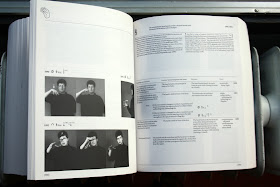Dictionary of British Sign Language / English.
British Deaf Association (ed. Brien, David):
Published by London: Faber and Faber, 1992
First edition, seventh impression. Paperback: laminated pictorial card wrappers. 1084pp. With small b&w photos of sign language throughout, as well as some facial expressions and line diagrams.
British Sign Language (B.S.L.) is the visual gestural language of the Deaf community in Britain and is the first or preferred language of over 70,000 people.
This is the first major B.S.L./English Dictionary to be published. It contains over 1,800 photographed sign entries ordered by linguistic principles according to the visual characteristics of the language. Each entry is notated with a description of how to produce the sign. A guide to the meaning(s) of each sign is provided in English.
The dictionary will be of particular interest to hearing and Deaf people (and their tutors) engaged in learning B.S.L. or English as a second language. Whether you want to learn B.S.L or teach it - or just improve your vocabulary - the Dictionary of British Sign Language is the authoritative place to begin.
The Dictionary of British Sign Language was compiled for the British Deaf Association by the Deaf Studies Research Unit at the University of Durham.
OLIVER CHANARIN
Controversial winner of the Deutsche Börse prize, with Adam Broomberg.
My favourite book is The British Dictionary of Sign Language, published by Faber and Faber in 1992. It contains 1,800 shots and is a great example of photography that’s both beautiful and useful.
See also
Nan Goldin Martin Parr Cristina de Middel and More pick their All-time PhotoBook favourites Photography
This exhibition focuses on the meaning and significance of photobooks concerning health care environments. Heart-rending, intimate stories on matters of life, sickness, death and personal loss, are observed and experienced by consecutive generations of photographers working in the documentary tradition. Martien Coppens (1908-1986), Koos Breukel(1962), Carel van Hees (1954), Rince de Jong (1970), Roy Villevoye (1960), and Albert van Westing (1960) unveil various aspects of the everyday lives of their friends and family, as well as people in their professional environment who suffer from a severe illness or find themselves facing grim adversity. The photographers record how these people, some of whom are very dear to them, try to deal with their illness or misfortune with a need to hold on to memories of a happier past, and to understand their slow deterioration and the bewilderment that comes with it. There is often a great sense of urgency: the clock is ticking.
The world of the loved one, the patient, is turned upside down. Suddenly, life is built around medical care and attempts to find a new sense of meaning and purpose. A new dimension is added to the concept of ‘home’: ‘home’ is no longer a safe and protected place, and consequently the patient no longer experiences it as such. ‘Home’ turns into a health care environment. Simultaneously, a different kind of reality suddenly becomes of vital importance close to home: the care facility. That turns into a new ‘home’ of sorts, in the shape of a transitory location of controlled care and attention. The hospital, the nursing home, the mental institution; they are like hotels – a temporary accommodation, often born out of necessity, sometimes unwanted; a place to meet fellow sufferers. The photographer infringes upon that environment; he/she considers the ‘home away from home’ his/her work environment.
The core of the exhibition is shaped by photobooks published by and on the Dutch public health care. In addition, photobooks on consumer driven health care and loss within one’s domestic circle and circle of friends are put on view, self-published by modern day photographers. Those publications are considered to be an extension of the genre. Within the genre, photobooks since post-war reconstruction constitute a category of their own.
After World War II photographers recorded their fascination of the harsh reality of human suffering in a number of photobooks. Each of the 25 photobooks selected for this exhibition represents a photographer’s strategy regarding the documentation of medical and personal care in public and private space, then and now. Not only do they show the progression of personal tragedy; they also display the development of care environments in The Netherlands, and the birth of a genre in documentary photography. In this exhibition you will find visual narratives on academic hospitals by the first generation of photographers to work in a tradition of humanist photography and who were members of the Dutch photographer’s guild (GKf). Among them are Eva Besnyö (1910-2003) and Ad Windig (1912-1996). Photobooks that were published after the Second World War are composed around the verb ‘to live’. Moralistic and patronizing in tone they speak of nursing and nurturing in a confined workplace; mental bewilderment and daily care; a ‘day in the life’ of a patient in a care environment that tries to mimic a home life. These publications subsequently make way for self-published and digitally produced book projects. The personal involvement reflected in those projects is domestic and local in nature, focused on the photographer’s own environment and family. Books on display by contemporary author-photographers like Linda-Maria Birbeck (1974), Annelies Goedhart (1979) and Jaap Scheeren (1979) reveal that approach.
Photobooks are selected that were groundbreaking in their day and in the way they depict the socially, often highly sensitive, themes of health care in text and images. Further, the books stand out for their technical execution, layout and way of photographic storytelling. In sum, this exhibition is about commissioners, photographers, graphic designers and graphic industry that have played an important role in the history of photography and graphic design.














Geen opmerkingen:
Een reactie posten